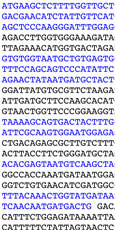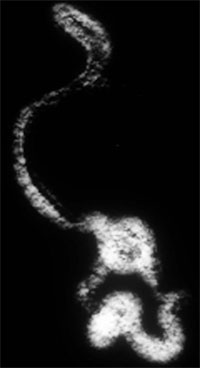Drawing with DNA
|
7.21.2005 -- On any given day, tens of thousands of biologists around the globe run DNA sequences of unknown function through a lightning-fast online algorithm called BLAST – typically submitting 200 to 400 base pairs, or “letters” of genetic code, to be matched against the billions of letters for known genes. Searching for similarities that can shed light on functional or evolutionary relationships, scientists routinely use BLAST to churn through and produce vast amounts of data. Everyday applications include genetic medicine and pharmaceuticals. Yet this process and, more generally, genomics remain dimly understood by the public.
“Ecce Homology,” an interactive “bioart” installation to be showcased at SIGGRAPH 2005 – in Los Angeles , July 31 through Aug. 4 – quite literally makes BLAST and genomics visible.
Headed up by new-media artist Ruth West – director of visual analytics and interactive technologies at the University of California, San Diego, National Center for Microscopy and Imaging Research, and research associate with the UCSD Center for Research in Computing and the Arts – the “Ecce Homology” project is an ongoing collaboration among 11 biologists, artists and computer scientists from UCSD, UCLA and the University of Southern California.
Named after Friedrich Nietzsche’s Ecce Homo, a meditation on how one becomes what one is, the project explores human evolution by examining similarities – a.k.a. “homology” – between genes from human beings and a target organism, in this case the rice plant.
“We are living in a time when we are generating enormous amounts of genetic data,” said West, who trained as a microbiologist and began her career in medical genetics. “But data is not knowledge – it’s not even information. A key concept of ‘Ecce Homology’ is to make an important subject like genomics accessible to the general public.”
“Ecce Homology” uses a combination of dynamic media, computer vision and computer graphics to visualize genomic data.
|
Custom software turns genes – incomprehensibly long strings of As, Cs, Ts and Gs – into luminous pictograms that resemble Chinese or Sanskrit calligraphy. Based on currently available biophysical information, the pictograms are scientifically accurate representations of proteins encoded for by the genes.
In the SIGGRAPH installation, the representations are rendered in a 40-foot wide and 12-foot tall space by five video projectors, with the figures for human genes/proteins shown along a vertical axis and for the rice along a horizontal.
A whole-body computer vision interface tracks the movements of visitors and allows them to interact with the installation. By moving their bodies slowly within the space, visitors can draw shimmering light-filled traces. When a trace sufficiently matches a pictogram in the human dataset, it triggers a real-time bioinformatics comparison: BLAST begins to run, searching through the rice data for a homologue – conducting in a novel (and visible) way the same sequence analysis done by scientists. Results are presented as two superimposed pictograms.
“This high-dimensional visualization reduces the complexity of sequence codes to the sorts of shapes or patterns that a human being can make sense of,” West said. “It is an artistic approach to extracting what’s important. And it is also an exploration of what art might have to offer for discovery in the sciences.”
|
“Ecce Homology” premiered in 2003 at the UCLA Fowler Museum of Cultural History.
At SIGGRAPH 2005, “Ecce Homology” is being showcased as part of the international conference’s Art Gallery and its Emerging Technologies program. It will also be featured in the August 2005 issue of Leonardo, an art, science and technology journal from MIT Press.
The project is supported by Intel Corp., NEC Solutions America/Visual Systems Division and groups at UCSD, UCLA and USC.
Photos and video available at: http://ucsdnews.ucsd.edu/newsrel/arts/EcceHomology.asp
Related Links
To learn more: http://www.insilicov1.org/
For more about SIGGRAPH 2005: http://www.siggraph.org/s2005/
Media Contacts
Inga Kiderra, (858) 822-0661 or ikiderra@ucsd.edu



